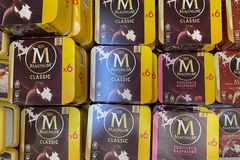
- Industry news
Industry news
- Category news
Category news
- Reports
- Key trends
- Multimedia
- Journal
- Events
- Suppliers
- Home
- Industry news
Industry news
- Category news
Category news
- Reports
- Key trends
- Multimedia
- Events
- Suppliers
Cargill Launches Refined Carrageenans for Reduced Sourcing Risks

1 Oct 2013 --- Cargill’s texturizing solutions business today launched a new generation of refined carrageenans derived from cultivated seaweeds – offering a high-performance solution for gelling, thickening and stabilizing food products, with reduced sourcing risks.

The market for wild red seaweeds, from which some carrageenans are traditionally derived, has become volatile and extremely tight in recent years. This is due to raw material scarcity caused by environmental factors, as well as local production quotas impacting supply and continuously increasing demand.
“All of the seaweed extract industry, which includes carrageenan and alginate, is growing and with this growth comes a realization that supply and demand does not match. There is an increasing demand for those types of products in China, as food habits change there in a country with a population of over 1 billion that creates additional needs for products such as alginate and carrageenan and therefore increased tension on raw materials,” Fabrice Bohin, Head of Hydrocolloids and European Functional System business at Cargill Texturizing Solutions.
“Because the availability of raw materials in China is not matching the demand or growth and due to the huge double-digit growth, just for internal consumption, growth went from zero in 2007 to extremely significant numbers now.” In addition to China, the demand for seaweed extracts used in food and many other non-food applications keeps growing as well. The squeeze on supply has meant increased volatility and supply risk. “In the past there was a crisis every ten years, now there is one virtually every month somewhere,” says Bohin.
Four years ago, Cargill saw that the problem of supply would accelerate, with certain particular events alarming them. Bohin particularly pointed to two events as causing concern. These were:
• The crisis in Asia in 2010 of availability because of sudden Chinese demand that created an unbalanced supply and demand, causing the price to go to unseen levels.
• In 2011, an earthquake in Chile caused the coast to elevate and some of the seaweed that was underwater went above it and died. The resource of one specific species became very tight.
Bohin pointed to four basic pillars that the company focused on to secure future supply. The first involves connecting the core competence of Cargill in risk management to the hydrocolloid business, in a sector that has not traditionally placed a huge emphasis in that space, due to an age-old abundance of raw materials. “Our first pillar includes a tripling of their raw material purchasing organization like seaweed with professional buyers who were able to speak with the farmers. We added crop analysts who work on data, including environmental, to anticipate what is happening on the crop side,” he explained.
The company also:
• Started to diversify both in origin and species of raw materials “so that we can have more solutions for supply.”
• Adapted its process, so that it can basically provide similar functionality with a different source of raw material.
• Worked on a proactive program of reformulation that was initially based on wild seaweed with cultivated seaweed.
New production technologies recently developed by Cargill not only allow the company to use alternative and more secure raw material sources for its carrageenans, but also enable improved functionality of the seaweed extracts.
To provide customers with the benefits of this improved functionality, a new family of carrageenan products has been brought to the market, forming the Satiagel range for the dairy market.
The SatiagelADF 130 series for cold filled creamy desserts, the SatiagelADG 200 series for hot filled creamy demouldable desserts, and the SatiagelABN 500 series for use in dairy beverages, all drawn from cultivated sources, are cost effective, versatile, easy to use, and offer excellent mouthfeel, creaminess and appearance properties. And the SatiagelPG series has been developed for the confectionery market and offers a broad range of textures, as well as quicker gelation and faster demoulding – helping to speed-up the manufacturing process.
“Our Satiagel carrageenan range provides superior performance for dairy and confectionery manufacturers and is versatile, cost competitive and sustainable”, explains Bohin.
“Cargill has developed its cutting-edge processing skills for seaweeds over the last 40 years. Our risk management expertise and our dedicated research and development programme for improved and differentiated extraction technologies allow our customers to access and rely on a unique range of carrageenans”, adds Bohin.
Cargill has established long-term relationships in the seaweed industry, often allowing for exclusive agreements with suppliers, and grown an extensive sourcing network to secure the necessary volume of seaweed. We support farmers and exporters with technical expertise to produce and transport high quality raw materials for a sustainable supply chain. And with dedicated professional buyers and crop analysts present locally in the producer countries, we supply our carrageenan customers with risk management solutions.
Carrageenans are part of Cargill texturizing solutions business’ unique portfolio of texturizers, ranging from single ingredients, such as xanthan gum, carrageenans, pectins, alginates, locust bean gums, starches and lecithins, to multi-component functional systems. Manufacturers benefit from Cargill’s extensive expertise in applications and are supported by its R&D centres across the world.
by Robin Wyers










